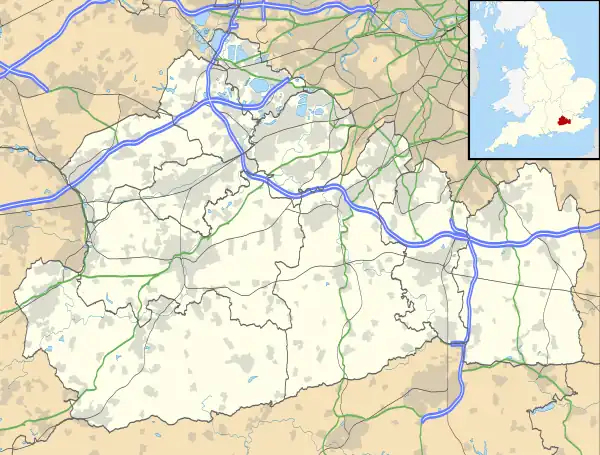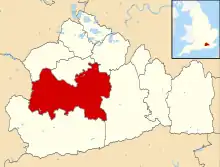Shalford, Surrey
Shalford is a village and civil parish in Surrey, England on the A281 Horsham road immediately south of Guildford. It has a railway station which is between Guildford and Dorking on the Reading to Gatwick Airport line.
| Shalford | |
|---|---|
| Village | |
_(3).jpg.webp) St Mary the Virgin's Church, Shalford | |
 Shalford Location within Surrey | |
| Area | 6.51 km2 (2.51 sq mi) |
| Population | 4,142 (Civil Parish 2011)[1] |
| • Density | 636/km2 (1,650/sq mi) |
| OS grid reference | TQ0046 |
| Civil parish |
|
| District | |
| Shire county | |
| Region | |
| Country | England |
| Sovereign state | United Kingdom |
| Post town | Guildford |
| Postcode district | GU4 |
| Dialling code | 01483 |
| Police | Surrey |
| Fire | Surrey |
| Ambulance | South East Coast |
| UK Parliament | |
It has one named locality, occupying the west of the area, Peasmarsh.
Shalford's village sign was designed by Christopher Webb and W H Randall Blacking in 1922, as part of a competition run by the Daily Mail. It shows Saint Christopher carrying the Christ Child over a shallow ford.[2]
History
Shalford appears in the Domesday Book of 1086 as Scaldefor. It was held by Robert de Wateville from Richard Fitz Gilbert. Its Domesday assets were: 4 hides; 1 church, 3 mills worth 16s, 11½ ploughs, 4 acres (1.6 ha) of meadow, wood worth 20 hogs. It rendered £20.[3]
The village also became well known for "the Great Fair of Shalford" which was set up by a charter issued by King John. In its heyday, it was said to have covered 140 acres (57 ha) and attracted merchants from across the country.
The original church, mentioned in the Domesday survey, no longer exists. An early Victorian church now stands in its place. St Mary's was built in 1846 with a lychgate and stained glass.[4] Many older cottages do survive. One of the finest properties, Shalford House, dated back to the Tudor period and featured a carved stone fireplace dated 1609. The house was demolished in 1967 to make way for a water treatment plant. There are many Grade II listed structures including stocks and whipping post.[5]
World War II
On 11 April 1944 two goods trains collided at Shalford. One of them consisted of tankers of aviation fuel en route to airfields in Kent. Leaks from the damaged wagons caused a major fire which was eventually brought under control by the Fire Brigade, with assistance of members of the local police and Home Guard volunteers, who used sandbags to contain the spread of the burning fuel. Nearby properties, including a potato and vegetable store, were badly damaged as was the steel road bridge over the railway that was buckled by the heat. The local pub, the Queen Victoria, escaped unharmed.[6]
Geography
The River Tillingbourne joins the River Wey at Shalford adjacent to the parish church. For centuries, the river provided an important source of income for the village with various local industries, such the manufacture of gunpowder, utilising it as a source of power. Cranleigh Waters joins the Wey at the northern terminus of the Wey and Arun Canal. Shalford was a landing place for barges, and continues to be visited by boats today – but for pleasure rather than trade.
The surviving mill is now preserved as a tourist attraction: Shalford Mill, a Grade II* listed building,[7] situated in the centre of the village opposite the Sea Horse public house, was built in the 18th century[8] and is now owned by the National Trust.
Notable residents
Some claim that the author of The Pilgrim's Progress, John Bunyan, once lived in hiding in a cottage called Horn Hatch on Shalford Common[9] and drew his inspiration from the fair held on the common and from the ancient route known as the Pilgrims' Way, which passes nearby, on its way to Canterbury.
Lt.Col. Henry Haversham Godwin-Austen (1834–1923), topographer, geologist, naturalist and explorer who surveyed the Himalayan region, including K2, sometimes known as Mt. Godwin-Austen, for a time had an estate in Shalford.
A watercolour sketch titled 'In Captain Pierrepont's Grounds' was painted by Anthony Devis (1729–1817) not long after Captain William Pierrepont of HMS Naiad acquired Shalford Manor in 1800.
Brigadier George Roupell, a Victoria Cross recipient, died in Shalford in 1974.
The Genesis singer/drummer Phil Collins had a home in Shalford named Old Croft, where he wrote music which would end up on his first solo album Face Value, and also the Genesis album, Duke.[10]
Localities
Peasmarsh
The settlement of Peasmarsh on the west bank of the river Wey between Artington and Godalming is contained in the parish. It consists of a large retirement home; Astolat and Weyvern business parks which include a large Land Rover service centre, Volkswagen Commercial Vehicles, SMC Renault, Harley Davidson, IGuzzini Illuminazione (lights), Marchon UK, Maui Jim (eyeware companies), Integrian security, WHSmith plc and Efamol essential fatty acids, and Doble powertest HV testing and equipment; and four short residential roads close to the River Wey Navigation including Tilthams Green. A woodland surrounding the rebuilt manor house, being higher up than most of the reclaimed marshland, is named Peas Marsh. A barn at Littlemarsh Farm, one at Tilthams Farm and Tilthams farmhouse are grade II listed.[11][12][13] There is also a C of E church; St Michael's. The water meadows form the Wey Valley SSSI.[14]
Demography and housing
| Output area | Detached | Semi-detached | Terraced | Flats and apartments | Caravans/temporary/mobile homes | shared between households[1] |
|---|---|---|---|---|---|---|
| (Civil Parish) | 623 | 511 | 287 | 270 | 30 | 0 |
The average level of accommodation in the region composed of detached houses was 28%, the average that was apartments was 22.6%.
| Output area | Population | Households | % Owned outright | % Owned with a loan | hectares[1] |
|---|---|---|---|---|---|
| (Civil Parish) | 4,142 | 1,721 | 36.6% | 35.7% | 651[1] |
The proportion of households in the civil parish who owned their home outright compares to the regional average of 35.1%. The proportion who owned their home with a loan compares to the regional average of 32.5%. The remaining % is made up of rented dwellings (plus a negligible % of households living rent-free).
References
- Key Statistics; Quick Statistics: Population Density United Kingdom Census 2011 Office for National Statistics Retrieved 21 November 2013
- "Domain parking page".
- Surrey Domesday Book Archived 30 October 2007 at the Wayback Machine
- Historic England. "Details from listed building database (1294444)". National Heritage List for England. Retrieved 9 May 2012. St Mary's Church
-
- Historic England. "Details from listed building database (1029494)". National Heritage List for England. Retrieved 9 May 2012. Fosters Row
- Historic England. "Details from listed building database (1029314)". National Heritage List for England. Retrieved 9 May 2012. Tilehouse Farm Barn
- Historic England. "Details from listed building database (1029498)". National Heritage List for England. Retrieved 9 May 2012. Stone base to cross
- Historic England. "Details from listed building database (1029499)". National Heritage List for England. Retrieved 9 May 2012. Mill Cottage, Watermill Cottage
- Historic England. "Details from listed building database (1029500)". National Heritage List for England. Retrieved 9 May 2012. Mill Lane Cottages
- Historic England. "Details from listed building database (1029501)". National Heritage List for England. Retrieved 9 May 2012. Debnershe
- Historic England. "Details from listed building database (1029502)". National Heritage List for England. Retrieved 9 May 2012. The Mill House
- Historic England. "Details from listed building database (1029503)". National Heritage List for England. Retrieved 9 May 2012. The First School
- Historic England. "Details from listed building database (1377773)". National Heritage List for England. Retrieved 9 May 2012. Gate to First School
- Historic England. "Details from listed building database (1029504)". National Heritage List for England. Retrieved 9 May 2012. Beech House
- Historic England. "Details from listed building database (1029505)". National Heritage List for England. Retrieved 9 May 2012. 20–22 The Street
- Historic England. "Details from listed building database (1029506)". National Heritage List for England. Retrieved 9 May 2012. Shalford Park Cottage
- Historic England. "Details from listed building database (1189242)". National Heritage List for England. Retrieved 9 May 2012. Whitnorth
- Historic England. "Details from listed building database (1189247)". National Heritage List for England. Retrieved 9 May 2012. The Seahorse public house
- Historic England. "Details from listed building database (1189256)". National Heritage List for England. Retrieved 9 May 2012. 36–40 The Street
- Historic England. "Details from listed building database (1189261)". National Heritage List for England. Retrieved 9 May 2012. 24–30 The Street
- Historic England. "Details from listed building database (1189301)". National Heritage List for England. Retrieved 9 May 2012. 16–18 The Street
- Historic England. "Details from listed building database (1246023)". National Heritage List for England. Retrieved 9 May 2012. Cemetery Chapel
- Historic England. "Details from listed building database (1246024)". National Heritage List for England. Retrieved 9 May 2012. Cemetery Lychgate
- Historic England. "Details from listed building database (1294358)". National Heritage List for England. Retrieved 9 May 2012. Lemon Bridge Cottage
- Historic England. "Details from listed building database (1294391)". National Heritage List for England. Retrieved 9 May 2012. Stocks and whipping post
- Historic England. "Details from listed building database (1294392)". National Heritage List for England. Retrieved 9 May 2012. Bridge over Tillingbourne
- Historic England. "Details from listed building database (1294443)". National Heritage List for England. Retrieved 9 May 2012. 69 Station Road
- Historic England. "Details from listed building database (1377772)". National Heritage List for England. Retrieved 9 May 2012. 49 & 51 The Street
- Historic England. "Details from listed building database (1377774)". National Heritage List for England. Retrieved 9 May 2012. 32–34 The Street
- Historic England. "Details from listed building database (1029494)". National Heritage List for England. Retrieved 9 May 2012. Cemetery wall
- Historic England. "Details from listed building database (1391835)". National Heritage List for England. Retrieved 9 May 2012. The Firs
- Historic England. "Details from listed building database (1393082)". National Heritage List for England. Retrieved 9 May 2012. War Memorial
- Rose, David (2016). Guildford Pubs. Stroud: Amberley Publishing. p. 81. ISBN 9781445657196.
- Historic England. "Shalford Mill (1294360)". National Heritage List for England. Retrieved 13 May 2017.
- Historic England. "Details from listed building database (1294360)". National Heritage List for England. Retrieved 9 May 2012. Shalford Mill
- Lawrence, Ralph (1950). Surrey (First ed.). London: Paul Elek. p. 109.
- Phil Collins (2016). Not Dead Yet. London, England: Century Publishing. pp. 159 & 169. ISBN 978-1-780-89513-0.
- Historic England. "Details from listed building database (1188371)". National Heritage List for England. Retrieved 9 May 2012. Barn in Peasmarsh
- Historic England. "Details from listed building database (1189307)". National Heritage List for England. Retrieved 9 May 2012. Barn in Peasmarsh
- Historic England. "Details from listed building database (1377775)". National Heritage List for England. Retrieved 9 May 2012. Farmhouse in Peasmarsh
- "Wey Valley Meadows" (PDF). Natural England. Retrieved 22 May 2020.
